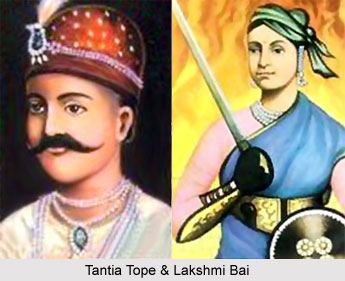Indian Army during the First War of Independence comprised two elements - the Native Armies of the British East India Company and fewer British Army units. In 1857, the three Presidency Armies of Bengal, Bombay and Madras consisted of near about 2, 33,000 Indian and 36,000 British troops, who were commanded by British officers. The mutiny of 1857 which sparked off in Bengal and later spread to the whole of north India has been correctly termed as the first organised fight for independence. As far as the army raised by the East India Company was concerned, there were already records of a number of mutinies both by Europeans and Indian troops.
The causes that lead to such large scale mutinies during the British rule were far and wide. Low rates of pay and allowances have always been the cause of discontent and all armies have pressed the point towards an advantage at one time or the other but more so a mercenary army. In 1764 Bengal sepoys mutinied for higher rates of pay and gratuities. European Officers and men in Bengal army revolted in 1765-66 for more allowances in a most organised mutiny against the government.
 The revolt first broke out in the Bengal Army garrison at Meerut on 10th of May 1857, after some troops were disgraced and imprisoned. Towards the latter part of 1856 the upheaval was centred on Oudh, the principal recruiting area of Bengal Presidency, but later extended to include Delhi and southwards to Indore and Jabalpur. The revolt soon spread to Lucknow and Kanpur. From July 1857, however, the tide turned. The British organised their forces and rushed to the relief of Delhi, Lucknow and Kanpur. With the capture of the capital, the trust and belief of the people of India in the ultimate success of the uprising disappeared.
The revolt first broke out in the Bengal Army garrison at Meerut on 10th of May 1857, after some troops were disgraced and imprisoned. Towards the latter part of 1856 the upheaval was centred on Oudh, the principal recruiting area of Bengal Presidency, but later extended to include Delhi and southwards to Indore and Jabalpur. The revolt soon spread to Lucknow and Kanpur. From July 1857, however, the tide turned. The British organised their forces and rushed to the relief of Delhi, Lucknow and Kanpur. With the capture of the capital, the trust and belief of the people of India in the ultimate success of the uprising disappeared.
After the First War of Independence, the heroic tales of outstanding valour of Tantia Tope and the Rani of Jhansi, Lakshmi Bai have become household lore throughout the country. Almost three-fourth of the Bengal Army was involved in the uprising. The British managed to control the spread of the uprising to the Madras and Bombay Army units. This control of spread was carried out by other Indian troops who, only some years earlier had been enemies of the British, which is the Sikhs, Gorkhas, troops of the Punjab Frontier Force and Punjabi Irregulars. The British were quite ruthless in the suppression of the uprising. While mopping-up operation continued, very harsh repressive measures were adopted by the British against the rebels and suspects. On 1st of September that year the governance of India was transferred to the British Crown, ending the centaury-old rule of East India Company.






